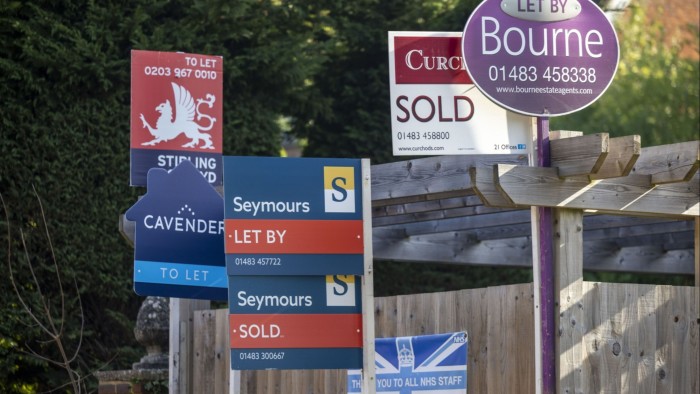Stay informed with free updates
Simply sign up to the UK house prices myFT Digest — delivered directly to your inbox.
UK house prices rose more than expected in May, supported by low unemployment, strong wage growth and easing mortgage rates, Nationwide said.
The average cost of a property rose 0.5 per cent between April and May to £273,427, mostly reversing the 0.6 per cent fall in the previous month, according to data released by the lender on Monday.
Prices rose at an annual rate of 3.5 per cent, up from 3.4 per cent in the previous month. Both measures are stronger than the 0.1 per cent month-on-month increase and the 2.9 per cent annual rise forecast by economists in a Reuters poll.
Robert Gardner, Nationwide’s chief economist, said that, despite economic uncertainties in the global economy, “underlying conditions for potential home buyers in the UK remain supportive”.
“Unemployment remains low, earnings are rising at a healthy pace, household balance sheets are strong and borrowing costs are likely to moderate a little if the bank rate is lowered further in the coming quarters as we, and most other analysts, expect.”
The figures suggest resilience after the slump in April, when prices and transactions fell as the stamp duty thresholds reverted to pre-2022 levels.
From April 1, the stamp duty thresholds reverted to pre-2022 levels, increasing the tax cost for many property buyers and resulting in many households rushing to complete transactions ahead of the changes.
Separate data published on Monday by the Bank of England showed net mortgage approvals for house purchases decreased for the third consecutive month, with a fall of 3,100 to 60,500 in April. Economists polled by Reuters expected a smaller decline to 63,000.
The BoE also reported that the “effective” interest rate — the actual interest paid — on newly drawn mortgages fell slightly to 4.49 per cent in April.
However, the rate on the outstanding stock of mortgages increased from 3.84 per cent to 3.86 per cent, indicating that the cumulative impact of interest rate increases since 2021 is still hitting households.
Elliott Jordan-Doak, economist at consultancy Pantheon Macroeconomics, said the removal of a worst-case scenario for tariffs thanks to the UK’s trade agreement with the US meant the economic backdrop had improved, supporting housing demand. House prices should rise 4.5 per cent this year, he predicted.
UK wages have been growing faster than inflation for about two years, while mortgage rates are edging lower.
The BoE last month cut rates by a quarter point for the fourth time since the middle of last year, taking them to 4.25 per cent, their lowest since 2023. Markets expect the central bank to cut the cost of borrowing by another quarter point before the end of this year.
Jonathan Hopper, chief executive of investment services company Garrington Property Finders, said that with the distorting effects of March’s stamp duty changes in the past, “the market is returning to a more settled dynamic, in which prices are once again being determined by the interplay of supply and demand”.
The BoE figures also showed households deposited an extra £14bn into Isas in April, the highest amount since data collection began in 1999.
This was mostly offset by the withdrawal of £11.5bn from instant access bank accounts paying interest, and £6.3bn from instant access accounts offering zero interest, the central bank said.
Individuals can hold up to £20,000 a year in a mix of cash and investments free of income and capital gains tax. But ministers are considering reducing the cash amount following calls from some City firms to funnel more money from savings into London-listed stocks.
https://www.ft.com/content/a068276c-5abc-4680-b825-1c0ef303dd2b


